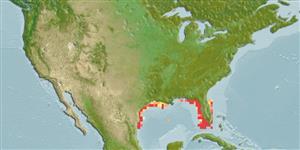Environment: milieu / climate zone / rango de profundidad / distribution range
Ecología
marino demersal; no migratorio; rango de profundidad 1 - 22 m (Ref. 89891). Tropical; 30°N - 24°N, 98°W - 80°W
Western Central Atlantic: southern Florida to Louisiana in the USA. Also in eastern Gulf of Mexico (Ref. 26938).
Tamaño / Peso / Age
Madurez: Lm ? range ? - ? cm
Max length : 25.0 cm TL macho / no sexado; (Ref. 7251); common length : 20.0 cm TL macho / no sexado; (Ref. 3815)
Usually has dark spot (larger than pupil) on lateral line just behind gill opening.
Body shape (shape guide): short and / or deep.
Occurs in sea grass beds from near shore to at least 22 m. Small individuals have been known to form small aggregations. Feeds primarily on invertebrates. Marketed mostly fresh and frozen (Ref. 9739).
Life cycle and mating behavior
Madurez | Reproducción | Puesta | Huevos | Fecundidad | Larva
Robins, C.R. and G.C. Ray, 1986. A field guide to Atlantic coast fishes of North America. Houghton Mifflin Company, Boston, U.S.A. 354 p. (Ref. 7251)
IUCN Red List Status (Ref. 130435: Version 2024-2)
Threat to humans
Harmless
Human uses
Pesquerías: comercial; carnada: occasionally
Herramientas
Special reports
Download XML
Fuentes de Internet
Estimates based on models
Preferred temperature (Referencia
123201): 23.4 - 26.7, mean 24.7 °C (based on 121 cells).
Phylogenetic diversity index (Referencia
82804): PD
50 = 0.5001 [Uniqueness, from 0.5 = low to 2.0 = high].
Bayesian length-weight: a=0.02291 (0.01064 - 0.04934), b=2.95 (2.78 - 3.12), in cm total length, based on LWR estimates for this Genus-body shape (Ref.
93245).
Nivel trófico (Referencia
69278): 3.5 ±0.37 se; based on food items.
Resiliencia (Referencia
120179): Medio, población duplicada en un tiempo mínimo de 1.4-4.4 años (Preliminary K or Fecundity.).
Fishing Vulnerability (Ref.
59153): Low vulnerability (15 of 100).
🛈
Nutrients (Ref.
124155): Calcium = 193 [96, 355] mg/100g; Iron = 1.2 [0.6, 2.4] mg/100g; Protein = 18.5 [17.2, 19.7] %; Omega3 = 0.185 [0.106, 0.336] g/100g; Selenium = 37.4 [17.9, 78.3] μg/100g; VitaminA = 18.7 [5.0, 62.8] μg/100g; Zinc = 1.16 [0.76, 1.73] mg/100g (wet weight);
